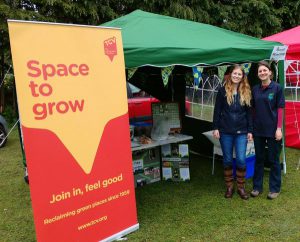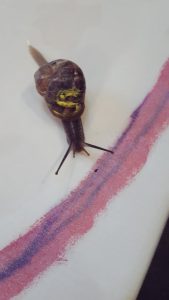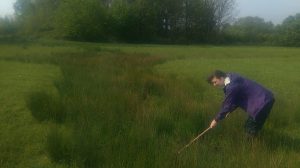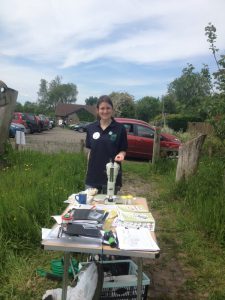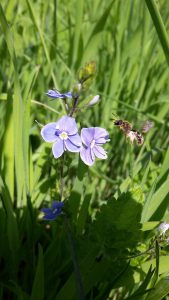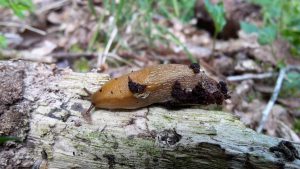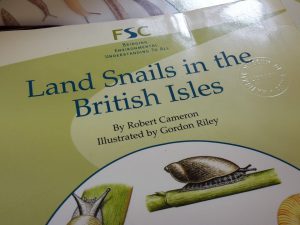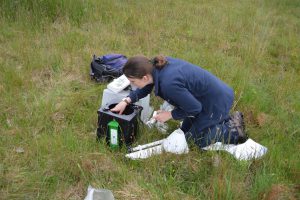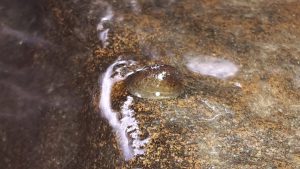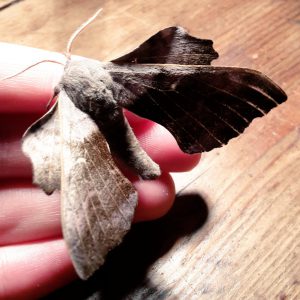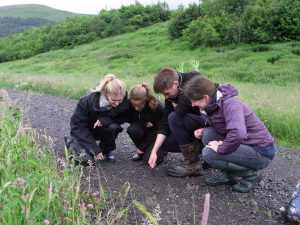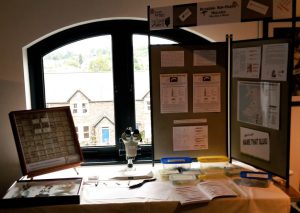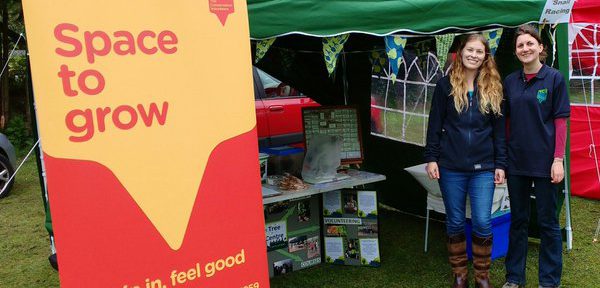
Hello again from Cardiff!
It’s been a very busy month for me, with lots of exciting things happening. I’ve been spending a lot of time out and about trying to get people to appreciate molluscs… not always the easiest task in the world!
“One, Two, Three…. SLOW!”
Last month I met up with my Natural Networks buddy, Delyth Hurley from TCV Tree Life Centre in Bristol.We decided to bring the joys of slugs and snails to Kingswood Park family fun day, and introduce them to the sport of snail racing. Despite the terrible weather, the live snails proved a hit, with kids enjoying holding them and watching them “race” across the table. Unfortunately we didn’t beat the world records of 2mins 20secs across a 14inch course… maybe next time?!
Amazing Experts
Mid may saw the Hay Literary Festival happening in Hay-On-Wye, where my mentor Dr Ben Rowson gave a fascinating talk on “The Ghost Slug and Molluscs Ancient and Modern” at Hay Castle. My project even got a cheeky mention, along with a few photos!
At the end of May I got to take part in my first bioblitz as an ‘expert’ at Magor Marsh… eek! This was particularly nerve wracking for me as I still feel I’m getting to grips with terrestrial molluscs, and we’d just had a long spell of hot dry weather! This meant that most slugs and snails would be hiding from the sunshine, trying to stay moist and not venturing out during the day. Despite this, several visitors managed to bring me some snails to look at, including a lovely little hairy juvenile. Thanks to a handy wooden bench, I even managed to find a small range of slug species to show adults and children, many who had a great time letting them crawl over their hands! I was also joined by Barbara Brown of OPAL, who was leading bug hunts, and somehow managed to teach me a little about bees (I usually try to avoid the cute and fuzzy). She even caught and identified a Shrill Carder Bee (Bombus sylvarum), considered the rarest species of Bumblebee in the UK! The species has been recorded at Magor Marsh before, but it just goes to show what a unique and amazing landscape the Gwent Levels is to be able to support such rare invertebrates.
“Hang on… so some snails have hairy shells!?”
Yep! Several species of snail in the UK have hairs on their shells, though in some these can wear off before they become adults. The hairs can reach up to 3mm long, but often just make the shell look a bit fuzzy unless you look closely. They are part of the periostracum – a thin layer of protein covering the calcium rich shell snail shell.
“But why have hairy shells?!”
Good question… and one that intrigued some scientists so much they wrote a paper on it. Interestingly some of the species with hairy shells are in completely different family groups, suggesting that they evolved independently, at different times and from different lineages. Hairy shells are found on species that live in moist microhabitats, like wet fallen leaves, damp grassland etc. Originally the theory was that hairy shells would allow the snails to be more streamlined when moving over wet surfaces, allowing them to move faster, but the study in 2005 found that actually it made the snails stick to wet surfaces more! This indicates that the hairs may help the snails to stick or hang on to slippery, wet plants. This helps prevent them from falling off and having to crawl up the plant again; a tiring journey for a snail.
Gallivanting in Gwent
At the beginning of June I headed off for the day to visit a couple of Gwent Wildlife Trust smaller reserves. I decided to have a look round Coed Meyric Moel near Cwmbran, and Branches Fork Meadows near Pontypool. From a mollusc point of view Coed Meyric Moel was not the most exciting place, particularly as I visited during a really hot and dry week! However, I absolutely loved Branches Fork Meadows, both for its varied mollusc fauna but also the lovely mixture of habitats.
The reserve is reached by walking along a national cycle route, so despite being close to Pontypool itself it felt like you were truly in the countryside. The reserve was an interesting mosaic of young woodland, a few veteran trees, scrub and wet heathy grassland, complete with a small grassy pond. I was intrigued to find a young golden toffee coloured slug with an obvious keel, which I struggled to identify at first. After consulting my guide I discovered it was a juvenile Limax cinereoniger (Ash-Black Slug), the adults of which usually have grey and black striped patterned tails with a dark unmarked mantle. The species is also an indicator of ancient woodland, but is known to persist at sites after trees have been cleared. This was interesting, as the area of the reserve I found the slugs in had some trees recently felled, suggesting that the Wildlife Trust were thinking of managing the reserve more for grassland than woodland. Fear not, the site immediately above the reserve is privately owned old plantation woodland, and may prove to be suitable habitat for the woodland specialist slug. I was really struck by this small reserve and the range of wildlife, and would definitely recommend a visit!
The best laid plans….
On the way home disaster struck, with my car breaking down spectacularly! Luckily the breakdown recovery people were excellent, and quickly sent someone on their way to pick myself, slugs and my stricken car up (apparently slugs don’t count as pets you need to inform them about). The fallout from this was frustrating as I had to cancel helping Barbara at an event, as I had no transport to get there with while my car was in the garage. This reminded me what an essential skill driving and access to a car is for working in the conservation or ecological sector, as it is practically impossible to get to and from sites otherwise, particularly in a rural area.
Type specimens and new species!
The next week was a busy one, seeing National Museum Wales hosting training for curators from other museums with mollusc collections, helping them learn how to identify potential type specimens in their collections. Type specimens are very important, as they act as an objective international standard reference of scientific animal names. The holotype is the single specimen that originally describes and bears the species name. Even if a better specimen is later found, the holotype cannot be replaced with another. Many other different ‘Types’ exist, with very precise rules and descriptions for them. While this training was going on, we also hosted a visit from Robert Cameron, a very lovely and extremely knowledgeable author of the FSC key to Land Snails in the British Isles.
He came to look at specimens held in the Museum’s shell collection from Madeira, to compare them with fossilised shells he had found that he believed could be new species! He was also joined by Willy De Mattia, who had come all the way from Italy to see the museum’s Madeiran shell collection to see if he could find any other examples of a new species he had discovered recently that may have been misidentified. He also very kindly donated the types of the species he had described to National Museum Wales, saying that the collection here was excellent and would be a fitting place for them to be. This was an amazing opportunity for me to chat with and witness two knowledgeable and friendly experts work. I also realised how much I had learnt in just a few months, being able to follow conversations that would have previously baffled me, and showing Robert Cameron how to use the photographic equipment.
Learning to love colliery spoil and moth night madness
Later that week I headed to Dare Valley Country Park, where Liam Olds of Colliery Spoil Biodiversity Initiative (previous Natural Talent trainee) introduced me to the beauty of the tips. While these acidic habitats aren’t great for molluscs, they are fantastic for a range of other wildlife, and I was pleasantly surprised at how lovely they were! After pitching our tents for an overnight stay, we headed off up the tips to set up some moth traps as part of National Moth Night and then off around the site with torches to see what slugs and snails could be found in the dark.
The next morning we were joined by a small but enthusiastic group of young amateur entomologists from AES Bug Club. We had a really fun day hunting insects, also showing them the moths and slugs we had caught the night before. They were a really enthusiastic, knowledgeable and interested bunch, and I look forward to meeting up with them again in July!
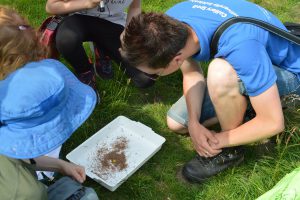
There’s a familiar face! Liam Olds and some enthusiastic children looking at insects found by sweep netting
That evening we headed off to Gellideg, near Merthyr Tydfil to join SEWBReC and the Friends of Gellideg Fields in a biological recording and BBQ event. This was well attended by residents of the local housing estate, and I had great fun helping Barbara Brown of OPAL by supervising pond dipping. For many of the children it was their first time, and they were absolutely fascinated, particularly by the many freshwater shrimps in the stream! I was also delighted to come across my first live River Limpet (Ancylus fluviatilis), one of three species of freshwater limpets found in the UK.
Finally arriving home, I decided to continue my own celebration of national moth night in my garden and was rewarded the next morning with a beautiful Poplar Hawkmoth! Ok… when I said I avoided the cute and fuzzy that was a slight mistruth as I do have a fondness for moths, with my MSc project last year being on the Scarce Hook-Tip moth (Sabra harpagula)…. I still think slugs are cooler though!
Me and my shadow
On Monday, Dr Ben Rowson and myself headed over to SEWBReC for a tour of their offices, to meet the staff and their LEMUR+ trainee Laura Parry. Laura and I are arranging to shadow each other for a few days, so that we can get an idea of each other’s traineeships, learn and share some new skills. She’ll be joining me in early July, when I look forward to teaching her about freshwater molluscs.
The beautiful Silent Valley
A couple of days ago I headed off with Ben to visit Silent Valley, a nature reserve tucked away close to Ebbw Vale. On the way back we dropped in on the Gwent Wildlife Trust offices in Ebbw Vale and met some more of the staff and their trainees.
We gave them a quick whirlwind introduction to slugs and snails at their adjoining new nature reserve. We look forward to some of them joining us in the field someday soon at Silent Valley…
To be continued!
Recording molluscs
The 18th June saw the Biodiversity Information Service celebrating 15 years, and I was lucky enough to attend an event with a range of organisations. This was a great opportunity to meet other biological recorders, some expert county recorders, and interest members of the public in recording molluscs.
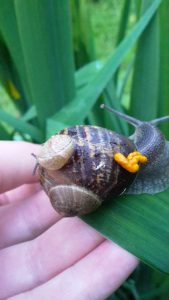
Common Garden Snail and juvenile found in my garden. (Check out the vibrant yellow poo from eating Yellow Flag flowers!)
The evening also saw a fascinating range of talks about nature and biological recording, including the launch of Aderyn, a new website system that allows people to view biological records in Wales. This is a really useful tool to see where species have been recorded in Wales, and shows just how under recorded some things are.
For example, the Common Garden Snail (Cornu aspersum), as the name suggests is a very common species in the UK, yet at the time of writing, this database shows very few records as people aren’t recording it.This means that if the population of the species starts decline or their range changes, we won’t have the historic data to compare it to and it will look like the species was always rare! This is one reason why I think it is worth recording even the most common species when out surveying, as the data can still be incredibly useful.
Phew! Well that just about brings you up to July. As you can see, it’s been a busy month with lots of time out and about meeting people. Hopefully I’ve managed to enthuse more people with a passion for molluscs!
Until next time…
Imogen Cavadino
Natural Talent Trainee: Non-Marine Molluscs
Don’t forget you can keep up to date with my daily antics on Twitter here or here.
A massive thank you to the Esmée Fairbairn Foundation for funding this amazing programme. Find out more about them here.
Also to National Museum Wales for hosting my placement. Be sure to drop in for a visit to the public collections when you’re in Cardiff!

